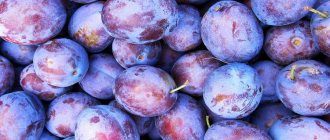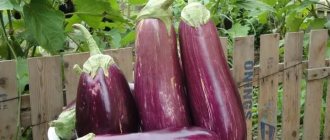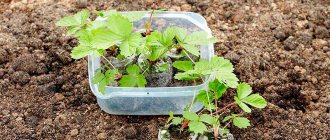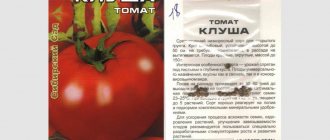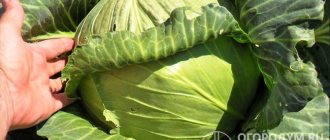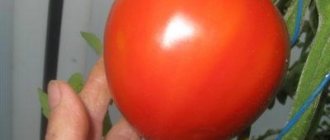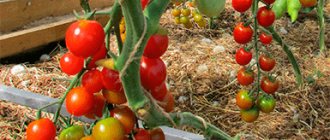Early ripening varieties of tomatoes for greenhouses
Who among us doesn’t like to treat ourselves to a fresh tomato salad? We dare to assure you that there are not many such people, especially when it comes to tomatoes from your own greenhouse. And for those who don’t like to wait for a long time, we advise you to pay attention to early-ripening varieties of tomatoes for greenhouses.
Super early varieties of tomatoes for greenhouses
Super early varieties include:
- “ Silhouette F1”
- ripens already on the 50th day after planting the seedlings in the greenhouse, produces a bountiful harvest even in very unfavorable conditions. The fruits of “Silhouette F1” have a pleasant taste, bright red color and weigh about 200 grams each. - “Ivet F1”
is another super-early tomato that produces a harvest a month and a half after planting in the greenhouse. The fruits are spherical, bright red in color and have a sweet taste.
Ultra-early ripening tomato varieties for greenhouses
Ultra-early ripening greenhouse varieties are considered:
- “Greenhouse early ripening F1”
- the first harvest of tomatoes of this hybrid can be obtained within 80 days after sowing the seeds. The bushes grow 60-70 cm in height and have a semi-spreading structure. “Greenhouse early ripening F1” tomatoes weigh from 120 to 180 grams, the skin color is dark red and the flesh is dense and juicy. - “Superstar”
- bushes of this variety grow up to 140 cm and require mandatory pinching. “Superstar” fruits are up to 250 grams in size, their pulp is sweet and juicy. The first harvest can be harvested within 85 days after sowing. - “Trapeza”
is a tall tomato variety that grows to a height of up to 180 cm. Its fruits are medium-sized (up to 20 grams) and are ideal for home canning. The bushes need staking, but at the same time they compare favorably with others in their resistance to drought, diseases and pests.
Early ripening varieties of tomatoes for greenhouses
Early ripening tomatoes for greenhouse cultivation include:
- “Mandarin”
is a cluster variety of tomatoes that requires mandatory gartering and pinching. Forms clusters of 10 bright orange fruits weighing up to 100 grams each. Ripens 90 days after sowing. - “Present F1”
is a medium-sized tomato (75 cm) that requires pinching. Forms medium-sized spherical fruits weighing up to 170 grams, which easily tolerate long-term storage and transportation. - “Sweet bunch”
is a tall variety of tomatoes (height more than 2.5 meters), requiring gartering and pinching. Forms clusters of 30-50 fruits weighing up to 20 grams each. The variety is distinguished by its ability to produce abundant harvests even in the most unfavorable conditions. The fruits are stored for a long time and have a pleasant sweet taste.
womanadvice.ru
Ultra early ripening tomato: watering scheme, fertilization
After about three weeks, the plants will need to be fed with a special compound. The optimal preparations are nitrogen, phosphorus and potassium fertilizers, which must be diluted in a bucket of water at 25, 40 and 15 grams, respectively. For one root you will need about half a liter of the prepared composition. During subsequent feedings, it is also optimal to add the above-described compositions. Potassium-containing fertilizers have a particularly positive effect.
Organic fertilizers are also suitable. The simplest thing is to dilute 1 liter of manure in 10 liters of water and leave it to infuse for about 2 weeks, then dilute the concentrate again at the rate of: liter of infusion per bucket of water. The last thing to fertilize the tomatoes is to apply a liter under each bush.
It is especially important not to miss the moment of feeding during the formation of ovaries and ripening of fruits. If we talk about watering, this variety does not respond well to waterlogged soil. Therefore, it is better to water less often, but more abundantly. In general, you need to focus here on the weather conditions in the region.
When watering, you must adhere to some rules described below.
- Do not get water on tomato shoots;
- If the weather is sunny and hot outside, then it will be optimal to water in the evening;
- If the sky is mostly cloudy without precipitation, then watering is allowed at any time convenient for you;
- Tomatoes should be watered with warm water, heated during the day in a barrel or in a bathtub;
- Drip irrigation will be the optimal watering system for Ultra-early ripening tomatoes.
The ultra-early tomato variety discussed in this article does not require special care, and will reward you with an excellent harvest if you regularly simply weed the bushes and loosen the soil. We should not forget about the close location of plant roots to the surface, so as not to harm them. It’s good to spud up the bushes occasionally.
The Ultra-early ripening tomato bush has the shape of a trunk, and there is no need to tie it to supports. However, those who have already grown these bushes on the site still recommend not neglecting this procedure. This way you can save the bush from damage in case of strong wind or storm. In addition, it is recommended to remove stepsons in a timely manner in order to reduce the ripening period of fruits.
Which early tomato varieties to choose?
Tomato varieties for planting in open ground
The category of early tomatoes has a number of advantages:
- disease resistance;
- maximum adaptability to climate change;
- excellent taste;
- stable and increased fertility;
- rapid maturation;
- ease of care.
Depending on where they grow, quickly ripening tomatoes are divided into groups:
- For unprotected soil;
- For a greenhouse environment;
- For apartment conditions.
"Aphrodite F1". Compact hybrid (determinate), bearing fruit 70-80 days after sowing. Its length is 50-70 cm, weight - 100-150 g. The round, bright fruits are very elastic in structure, making them excellent for transportation. They are universal in their direction.
"Valentina." This tomato, a super early variety, is particularly hardy and withstands drought. It is characterized by a high content of ascorbic acid. Reaches 70 cm in height. Ripening occurs 95-100 days after planting. Does not require the formation of bushes. A ripe tomato has a rich red color and a plum-like shape. Its skin is dense and rough, which makes it resistant to cracking.
"Benito F1". A low plant (40-50 cm) with a growing season of 70 days. A ripe vegetable is fleshy in structure and oblong in shape. The weight is quite large (up to 150 g). Benito F1 is not prone to verticillium wilt, is resistant to fusarium and is universal in use.
"Don Juan". The variety ripens 90-100 days after sowing. Its distinctive feature is its unusual elongated shape with a pointed “nose”. Early ripening fruits are crimson in color with longitudinal pale yellow stripes. They can be stored for a long time and are suitable for canning.
"Doll F1". A subspecies with a pink color, which is popular due to its high yield. Its length is at least 85-90 cm. Requires moderate frequency of pinching. The average weight ranges from 150 g to 200 g, but with careful care it can reach 450 g. It is used for processing and fresh consumption.
Note! In order for ultra-early varieties to have high productivity, proper soil preparation is necessary. Feed it with rotted manure (8-10 kg/m²). The soil should be fertilized with a mineral-organic complex (15 g of urea, 25 g of potassium magnesium and 50 g of superphosphate per 1 m²).
Varieties for greenhouse cultivation
The earliest varieties of tomatoes are represented by the following types: “Golden Brush”, “Yarilo”, “Mandarinka”, “Poznan”, “Greenhouse early ripening F1”, “Sugar plum raspberry”, “Sweet bunch”, “Blagovest”, “Superstar”, “Meal”, “Present F1”, “Friend”, “Cavalier”, “Funtik”.
"Golden brush" An indeterminate hybrid, 1.5 m long. It bears fruit 96-98 days from the moment of planting in protected ground. Tomatoes in this group are small in size (25-30 g), but have a pleasant taste. Outwardly, they slightly resemble a yellow-golden pear. They need to be pinched and tied up.
"Tangerine" Tall indeterminate plant with a growing season of 90-100 days. In clusters of this type, up to 10 deep orange tomatoes weighing 75-110 g grow. Their value is not only in their wonderful taste, but also in their invulnerability to difficult weather conditions.
"Sugar plum raspberry." Semi-determinate bush that gives a harvest on 85-97 days. Most often it stretches to a height of 105-140 cm. The ripe vegetable stands out among others with its crimson hue and plum-like shape. The advantage of these tomatoes is the significant amount of vitamins they contain and their delicate taste. They are stored for a long time and can be easily transported. Gartering and pinching are an indispensable rule for a generous harvest.
"Sweet bunch" The tallest type (from 3 m), which must be tied up and formed into 2 stems. Gives multiple rich harvests. Clusters of round and sweet fruits, 20-50 pieces each, look like bunches of grapes.
"Meal" A tasty hybrid with oval fruits (15-20 g) of bright red color. The fixed stem length is 160-175 cm. Good for long-term preservation and canning, as well as for fresh consumption. Particularly popular for its vitality and endurance.
"Superstar". Semi-determinate, excellent for sheltered areas or protected soil. A large (190-260 g), flat-round and sweetish vegetable, used in salads. The addition of a meter-long trunk is always welcome.
For balconies and apartment growing
The following subspecies are common: “Indoor Surprise”, “Minibel”, “Florida”, “Indoor Pygmy”, “Balcony Miracle”, “Siberian Precocious”, “Pinocchio”, “Garden Pearl”, “Bullfinch”, “Tiny Tim”, "Angelica", "Ballerina".
"Room Surprise" Among tomato crops intended for cultivation at home (on balconies or loggias), this variety produces a bountiful harvest first (on the 80th day). This is a compact vegetable (up to 45 cm) that does not require the formation of shoots. Its weight ranges around 60 g. The red plum-shaped fruit can be either canned or cut into a salad.
"Minibel". Ultra-early ripening varieties for cultivation under film cover, determinate. The plant is miniature (the stem is no longer than 35-40 cm), but it bears fruit well even in the absence of proper care and insufficient lighting. Tomatoes of this type are small - 15-20 g. They taste moderately sweet with a slight sour note.
"Indoor pygmy." A potted crop for universal use, which has proven itself well in cultivation on terraces, balconies, loggias, as well as in dense plantings of vegetables and flowers. Low-growing standard trunks (25-35 cm) of tomato can be done without pinching. The pygmy bears a bountiful harvest of ripe, sweet red tomatoes that are round in shape.
"Pinocchio". After sowing, the standard low plant matures in 90-95 days. Miniature fruits weighing no more than 15-20 g, round in appearance and sweet and sour in taste. The stepson procedure is not required. Pinocchio tomatoes are in demand among vegetable growers due to their decorative properties and high fertility.
"Garden Pearl". Another variety that is recommended for home use (on a windowsill or balcony). This is one of the richest varieties of crops in terms of yield, which produces about 350-400 pink fruits in one season. Super early tomatoes appear already on the 82nd day. The stem is creeping, no more than 40 cm in length. There is no need for pinching. In addition to nutritional value, tomato has good decorative qualities, so it looks great in a flower garden.
Choosing an early ripening variety of tomatoes will not be difficult if you decide in advance in what conditions you plan to cultivate.
nasotke.ru
Classification of varieties by ripening time
This culture is characterized by different ripening periods - from early to late. There are also ultra-early ripening hybrids; harvesting can begin 75-80 days after planting. They are usually not very productive or very tasty because they lack natural light.
Ultra early varieties
Ultra early ripening tomatoes:
- Cherry flow F1,
- Children's sweetness,
- Lark F1,
- Olya F1,
- Sanka.
To have tomatoes on the table, gardeners begin planting ultra-early varieties early and harvest the harvest within 75 days.
Early ripening varieties 50-80 days
Early ripe tomato variety for the greenhouse:
- "Antonovka honey"
- "Marshmallow in chocolate"
- "Golden domes",
- "Malachite Box",
- "Citrus Garden"
Any early ripening variety of this crop is capable of producing a harvest within 80 days after the appearance of the first sprouts of seedlings. This group includes short, standard tomatoes, and medium-sized determinate varieties.
If your region has short daylight hours, then plant early varieties of tomatoes for the greenhouse:
- Leopold F1,
- Diva F1,
- The Tsar Bell.
Mid-season varieties 90-120 days
Mid-season tomatoes ripen 100-120 days after planting. It is advisable to place the seedlings on the south side of the greenhouse so that they receive more sunlight.
A very popular mid-season tomato variety for the greenhouse: Moscow delicacy.
Also, other varieties and hybrids are also trusted by gardeners:
- Blagovest F1,
- Loyalty F1,
- Verlioka plus F1,
- Giant of the Moscow region,
- Suitor,
- Moscow pear,
- Budenovka,
- Koenigsberg,
- Kostroma F1,
- Siberian miracle,
- French grape.
Late varieties 120-150 days
Late varieties of tomatoes for greenhouses are extremely popular in all regions of the country. Receiving a lot of light and sunlight, they fill with juice and sweetness. In order for them to ripen, they must be planted exactly on time. Planting dates are indicated on the packaging.
The most favorite variety belongs to the late ripening variety -
- Bull's heart
- De Barao,
- Titan, Date,
- Finish as well as hybrid
- Vladimir F1.
New varieties of tomatoes for greenhouses
The time has come when many gardeners begin preparing for the new season. When buying tomato seeds, you should consider the conditions in which they will be grown: in open ground or in a greenhouse. To grow tomatoes indoors, you usually buy seeds that have already been tested, or you can turn your attention to new varieties of tomatoes for greenhouses.
Since tomatoes are a heat-loving crop, it is better to grow them, especially in areas with short and cool summers, in greenhouses. Depending on the size of the bush, tomatoes are classified as indeterminate and determinate. The first are tall plants that constantly grow both in length and width. Therefore, they require pinching and gartering. The second ones are relatively low-growing plants, so they do not require pinching.
Tomato varieties also differ in terms of ripening: they are early ripening, early ripening, ultra-early ripening. At the same time, determinate varieties ripen faster than indeterminate varieties.
10 best varieties of tomatoes
- Alliance F1 is an early-ripening tomato variety for greenhouses. Semi-determinate, high-yielding and promising tomato, characterized by early ripening. It has round, slightly flattened fruits. Up to 5 ovaries are formed in one brush. Dense, fleshy fruits have an excellent sweetish taste.
- Fantasio F1 is an indeterminate tomato variety for greenhouses with a medium-early ripening period. Up to eight fruits of a raspberry-diamond hue are formed in one brush. The fruits are round, fleshy, dense, and taste very sweet. A distinctive feature of the hybrid is its high resistance to late blight.
- Loreli F1 is an indeterminate tomato with a long growing cycle in greenhouses. The round-flattened fruits have a beautiful bright red color. Tomatoes are suitable for long-term storage. Resistant to many diseases and pests.
- Pietro F1 - this new early, tall tomato tolerates heat well. Produces very dense, round, bright red tomatoes that are tasty and sweet. Perfectly stored and transported.
- Fenda F1 is an early pink tall variety. Hardy and versatile. The fruits are very tasty, sweet and sugary, dense and resistant to cracking. The variety is high-yielding and is distinguished by high resistance to diseases.
- Junior F1 is an ultra-early ripening variety of tomatoes for greenhouses. The weak-leaved plant grows up to 60 cm in height. The fruits are red, slightly ribbed. Up to 2 kg of tomatoes are often harvested from one bush.
- Snow Fairytale is another ultra-early ripening variety of tomatoes grown in greenhouses. Up to 30 fruits weighing 200 g are sometimes collected from one bush. An interesting feature of this variety is that technically ripe fruits are white and only then begin to turn red. On one bush you can see red, white and orange fruits.
- Sevruga is a determinate, mid-season, large-fruited tomato variety for greenhouses. With good care, you can grow a fruit weighing up to one and a half kilograms.
- Siberian Trump - a large-fruited variety that can be grown both in greenhouses and in open ground. Delicious sweet fruits weighing up to 700 g have a red-raspberry color.
- Alsou is another new product among tomato varieties for greenhouses. Plants grow up to 80 cm in height. The fruits weigh from 500 to 800 g. The tasty, beautiful red fruits have excellent transportability.
The best guide when choosing seeds for greenhouses is your experience. Don’t stop only with long-used tomato varieties, but try new hybrids, and then tomatoes with new unusual qualities will appear on your site.
womanadvice.ru
Features of growing ultra-early tomatoes
Ultra-early ripening tomatoes are most often of the determinate type, while many of them can also be standard. Such tomatoes are usually easier to care for and also unpretentious. And yet there are some rules, the observance of which will contribute to a rich harvest.
- First of all, you need to choose the right seeds for planting. At the same time, we look at where we will grow tomatoes and why. Growing tomatoes in more detail.
- Preparing ultra-early tomato seeds for planting. The first thing to do is to disinfect the seeds in a solution of potassium permanganate. Next we soak, germinate and plant. By the way
, for a better effect, the seeds can be treated with growth stimulants. Everything about preparing seeds. - Tomatoes are usually planted as seedlings, and only in the southern regions is the seedless method used. Important
! Seedlings should be 45 - 55 days old. - An important point is the hardening of seedlings. We begin hardening 2 weeks before planting in open ground.
- Feeding. The importance of fertilizing is obvious, and it must be there. All about feeding tomatoes.
- Regular watering only with settled and warm water. These tomatoes most often have a shallow root system, which means that the top layer should never dry out. Water as it dries.
- Prevention from diseases. This includes: seed and soil preparation, crop rotation and routine biofungicide treatments. Read more about fungicides in this article.
Good luck to you!
Tomato varieties for greenhouses: large, productive, low-growing, early - Circle of Knowledge
Svetlana Koltsova
Photo © google.com
The most common is growing tomatoes in open ground conditions. But under some conditions this method is inconvenient or simply impossible. For example, the need to grow tomatoes exclusively in protected soil arises in conditions of a fairly cool climate or in order to obtain the earliest possible harvest.
To obtain the most abundant and high-quality harvest possible, you need to know which varieties of tomatoes are best suited for the greenhouse.
Ultra early ripening tomato: reviews from gardeners
Sergey Anatolyevich, Yaroslavl: “In general, I heard from friends that the Ultra-early tomato has high immunity to most common diseases. That is why I purchased the seeds of this variety. When growing, for the purpose of prevention, I still treated the bushes with Bordeaux mixture and carefully monitored the level of humidity in the greenhouse. Especially with changeable weather and temperature conditions. And the Ultra-Ripe tomato gave me good yield.”
Ekaterina, St. Petersburg: “In general, I liked the Ultra Early Ripe tomato. The yield is good, the taste is pleasant. Excellent Ultra-early ripening tomatoes are suitable for both salads and pickles. My conclusion about growing this variety is that it is optimal to grow the Ultra Early Ripe tomato on your own plot, since with minimal effort, you can get a fairly enviable harvest in a particularly short period and enjoy the fruits of tomatoes before others.”
Tomato Ultra early ripening: video about the variety
The best varieties of tomatoes for greenhouses
The purchased planting material must meet a number of requirements. In particular, it is desirable to have good taste, compliance of the selected variety with the expected growing conditions, level of disease resistance and expected yield. Of course, it is impossible to fully embody all the listed qualities in one variety for greenhouses, and each of the available varieties, to a greater or lesser extent, possesses some of the listed qualities, due to which it has a specific area of application.
For example, there are salad varieties of tomatoes for greenhouses. This list includes such varieties as “Monomakh’s Hat”, “Mikado”, “Cardinal”, “Dream”, “Eagle Heart”, “Orange Miracle”, “Queen of the Market”, “Biysky Rozan”, “King of London” , “Russian Soul”, “Canadian Giant”, “World Record Breaker”, “Abkhazian” and “Chernomor”. They can also be classified as large varieties of tomatoes for greenhouses. Due to their rather large size, the fruits of these varieties are not suitable for preservation in greenhouses, since, firstly, in their entirety they will not fit into the neck of a standard glass jar, and secondly, they are highly likely to collapse during heat treatment.
In addition to those listed, varieties of large-fruited tomatoes for greenhouses include the following names: Abakan pink, Altai miracle, Andreevsky surprise, Grandma's secret.
In addition to fairly large-fruited varieties for greenhouses, cherry tomato varieties for greenhouses have also gained wide popularity. Due to the small size of the fruits and their dense structure, these varieties are excellent for canning and preparing various snacks. In addition, due to the compact size of a bush of this variety, it can also be grown in a city apartment. The most popular representatives of this group of varieties are the following: “Minibel”, “Bonsai”, “Yellow Cherry”, “Cherry Tomato F1”, “Red Cherry”, “F1 Golden Bead”, “F1 Zelenushka”, “F1 Marishka”.
An important factor, especially when growing a crop for sale, is the speed of its ripening. Early varieties of tomatoes for greenhouses allow you to obtain ripe fruits in record time from the moment of emergence. Some of the varieties listed below can begin harvesting ten weeks after the first leaves appear. Ultra-early ripening tomato varieties for greenhouses are mainly represented by hybrids that are not capable of inheriting the characteristics of the mother plant, but at the same time have excellent characteristics during the ripening period. This list includes such varieties as “Samara F1”, “Renet”, “Hurricane F1”. Early ripening varieties of tomatoes for greenhouses include such names as “Druzhok F1”, “Typhoon F1”, “Poisk F1”, “Ilyich F1”, “Dina”, “Verlioka F1”, “Semko-Sinbad F1”, “Semko-98 F1” "
In addition, there are specialized varieties of tomatoes for polycarbonate greenhouses. Some of these varieties, during the selection process, have acquired the ability to continuously grow the stem, which makes it possible to obtain a tomato harvest over a long period, until late autumn. These tomato varieties for greenhouses are called indeterminate. To ensure normal fruiting, such varieties require certain stem care, but if this is provided, they are able to bear fruit continuously for a very long time. The list of such varieties includes De Borao red, hybrids Ivanhoe F1, Alexia F1, Demirosa F1, Pink Lady F1.
There are also other types of specialized varieties, for example, determinate varieties of tomatoes for greenhouses, the growth of the stem of which stops after the formation of four or five clusters, and semi-determinant varieties of tomatoes for greenhouses, the growth of which does not stop after the formation of several clusters, but is still significantly slower. growth of indeterminate varieties.
Some of the most popular semi-determinate varieties are Ural Multifruit and Toyota F1.
Determinate varieties in temperate climates can be grown in open ground, but to obtain an earlier harvest or if the weather is cool enough, it is best to place such varieties in greenhouses. The most popular varieties of the latter type are Bobcat F1 and Jane.
Basically, indeterminate and semi-determinate varieties belong to late varieties of tomatoes for greenhouses. This group of varieties is characterized by a long period of harvest ripening (about 115-130 days from the moment of germination) and fairly large fruits, weighing from 150 to 350 g.
As mentioned above, tall indeterminate varieties require special care to ensure the formation of an effective fruiting stem. One of the methods of such care is pinching - removing side shoots from the main stem to ensure the formation of only one fruiting shoot. Since this procedure takes a lot of time, non-sapling varieties of tomatoes for the greenhouse are quite popular. This group mainly includes low-growing and medium-growing varieties that are not prone to the active formation of additional stems, which would subsequently have to be removed to save space on the site and provide sufficient nutrition to the main stem.
Basically, the harvest of such varieties ripens 95 days after emergence. The most famous varieties of this group include Dubok, Nevsky, Gnome, Cio-Cio-San, Yantarny, Buyan.
Early ripening varieties of tomatoes for greenhouses allow you to get a harvest in the shortest possible time, which is especially important when growing tomatoes for sale. Many of the varieties and hybrids belonging to this type are capable of producing a harvest in 95 days. This group includes the following varieties: Druzhok, Scorpio, Gina, Soyuz 3, Soyuz 8, Rosy cheeks. Ultra-early tomato varieties for greenhouses are capable of bearing fruit in 80-85 days, and some varieties (for example, the Benito F1 hybrid) produce a harvest within 70 days after sowing. Super early varieties of tomatoes for greenhouses include the following: Alpha, Amursky Shtamb, Aphrodite F1, Gina, Don Juan.
In addition to purely technical aspects of the selected varieties, such as harvest volume or average fruit size, an important argument when choosing seedlings is the taste of the expected harvest. Therefore, sweet varieties of tomatoes for greenhouses are quite popular. For example, lovers of sweet tomatoes grow varieties such as: Ox Heart, Brown Sugar, Black Moor.
In addition to the most common red tomatoes, there are groups of varieties with flesh of a different color. Each group of varieties, depending on the color of the pulp, has its own characteristics.
For example, pink varieties of tomatoes for greenhouses are slightly more demanding in terms of growing conditions compared to the most common varieties. Moreover, the fruits of such varieties generally contain a much larger amount of useful substances: vitamins, microelements and antioxidants. Therefore, such varieties are recommended for use for a number of diseases of the gastrointestinal tract. Also, the main part of the varieties of this group are distinguished by much larger fruits compared to red tomatoes.
Varieties of pink tomatoes for greenhouses include the following names: Abakan pink, De Barao pink, Wild rose, Pink cheeks. The most famous varieties of this type are Persimmon, Honey Drop, Orange, Yellow Date.
Like the results of selection of many other crops, Dutch tomato varieties are distinguished by very high resistance to various types of diseases and excellent yield indicators. New varieties of tomatoes for greenhouses of Dutch selection include such names as Bobcat F1, Crystal F1, Pink Paradise F1, President II F1, Skif F1, Tarpan F1.
In addition to the formation of the characteristics of the fruits themselves, as a result of selection, varieties with different ways of forming inflorescences were developed. In particular, varieties of truss tomatoes have recently become quite popular for greenhouses, in which the fruits ripen not on single stalks, but in clusters, which greatly simplifies the harvesting of such a crop. In addition, the fruits of such varieties are distinguished by a fairly dense structure and the ability to tolerate storage and transportation well. The fruits are also characterized by high resistance to cracking. The most famous representatives of this group are such varieties and hybrids as F1 Intuition, F1 Reflex, F1 Instinct, Cio-Cio-San.
Advantages and disadvantages
Like all very early varieties, Ultra-early ripening F1 has practically no drawbacks, except that it requires tying up, despite its short stature, but it needs to be tied up because the heavy clusters with ripe fruits bend the bush to the ground.
This tomato has several advantages:
- early maturation;
- almost simultaneous ripening of tomatoes;
- the tomato is absolutely unpretentious;
- high immunity and resistance to diseases characteristic of tomatoes;
- not afraid of low temperatures;
- easily tolerates sudden temperature changes;
- low maintenance requirements;
- suitable for whole-fruit canning;
- high degree of keeping quality;
- excellent transportability;
- keeps up evenly and amicably.
If you follow at least the minimum, most necessary rules of care, then Ultra Early Maturing F1 will gratefully respond with a good, stable harvest.
Yield varieties of tomatoes for greenhouses
A fairly important characteristic of the cultivated variety is its yield level. Considering the limited area of the greenhouse, significant yields can only be achieved if the bush itself is of significant height.
Therefore, the highest-yielding tomato varieties for greenhouses belong to the type of indeterminate tall varieties.
Due to the significant height of the bush, with a constant occupied area in the greenhouse, such varieties are capable of producing the largest volume of yield per unit area of the greenhouse. This list includes the following varieties: “Honey Spas”, “Pink Tsar”, “Midas”, “Scarlet Mustang”, “Mushroom Basket”, “Southern Tan”.
Medium-sized varieties of tomatoes for greenhouses, despite their slightly lower specific yield, have a higher rate of fruit ripening. For this reason, in order to obtain an even harvest of tomatoes, in addition to tall varieties, bushes of medium height are also planted in greenhouses. Medium-growing varieties include the following: “Ballerina”, “Seagull”, “Riddle”, “Eleanor”, “Pink Honey”, “Lady”, “Asteroid”.
Photo
To better understand what ultra-early ripening tomato varieties for greenhouses look like, you can look at the photographs below.
Ultra early ripening variety
Variety Alpha
Variety Amur standard
Variety Snowdrop
You can also watch this video, where an experienced gardener will tell you about the Ultra-early variety.
Ultra-early ripening varieties of tomatoes for greenhouses are a frequent choice of gardeners. Their main advantages: high and early yield, strong immunity to diseases and ease of care. And the sweet taste and pleasant aroma of such tomatoes will only add to their popularity.
Low-growing varieties of tomatoes for greenhouses
Tall tomato varieties mainly belong to the mid-season and late-season types, which makes them difficult to grow in cool climates. Low-growing varieties have much better frost resistance and low susceptibility to sudden changes in weather conditions. Since most varieties of this group are intended for cultivation in cool climates, their ripening time is minimized, therefore a fairly large number of early and ultra-early varieties belong to this type.
The most famous representatives of this type of varieties are such as Velvet Season, Sibirskaya Troika, Bulat F1, Koenigsberg, Olya F1.
As mentioned above, modern varieties of tomatoes for greenhouses are selected in order to highlight a certain set of qualities necessary for the use of the resulting fruits in a particular area.
For example, varieties intended for fresh consumption and having a fairly soft structure are not suitable for canning, since the fruit will be destroyed during heat treatment. Also, varieties with the highest disease resistance do not always have high taste and pleasant appearance.
Thus, popular varieties of tomatoes for greenhouses can be divided according to the sets of qualities necessary for the gardener purchasing them.
For example, the most promising tomato varieties for greenhouses in terms of yield levels include De Barao red, as well as Hybrid Ivanhoe F1. According to the speed of crop ripening, in addition to those listed above, we can name Semko-Sinbad F1, Hurricane, Ivanhoe F1.
Among the varieties that are most resistant to various diseases, we can name “F1 Roma”, “Chio-chio-san”, “Blagovest F1”, “Budenovka”, “Evpator F1”, “Intuition F1”, “Erema F1”, “Kostroma” F1".
In some cases, the ability of fruits to retain their properties for a long time is almost more important than taste and yield levels. Of the varieties whose fruits can be stored for the longest time, we can name “Volgogradets”, “F1 Ivanovets”, “F1 Krasnobay”, “F1 Salahaddin”, “F1 Akatuy”.
In addition, a number of varieties can be distinguished with a fairly aesthetic appearance of the fruit. This list includes such varieties and hybrids as “Black Prince”, “Beautiful Lorraine”, “Tiger Striped”, “Fireworks”.
krugznaniy.ru
Characteristics
The “Ultra Early Maturing” tomato was bred by Siberian breeders in the 21st century. It can be grown in any region of the Russian Federation. The variety is distinguished by simple inflorescences, each of which contains about 8 fruits. Due to their small size, tomatoes are excellent for whole-fruit canning. When heat treated, their skin never cracks. In addition, fresh vegetable salads and juice are prepared from these tomatoes.
From one square meter of planting, about 15 kilograms of harvest are usually obtained.
You can compare the yield of this variety with others in the table:
| Variety name | Productivity |
| Ultra early ripening | 15 kg per square meter |
| Rocket | 6.5 kg per square meter |
| Summer resident | 4 kg per bush |
| Premier | 6-9 kg per square meter |
| King of Kings | 5 kg per bush |
| Stolypin | 8-9 kg per square meter |
| Long Keeper | 4-6 kg per bush |
| Black bunch | 6 kg per bush |
| Grandma's gift | 6 kg per square meter |
| Brawler | 9 kg per bush |
The greenhouse tomato “Ultra early ripening” F1 is characterized by the following advantages:
- Precocity.
- Harmonious ripening of fruits.
- Disease resistance.
- Unpretentiousness.
- Suitable for whole-fruit canning.
Tomatoes of this type have practically no disadvantages.
Read on our website all about tomato diseases in greenhouses and ways to combat them. And also about high-yielding and disease-resistant varieties, about tomatoes that are not subject to late blight.
Largest seed producers
Every major seed producer must be licensed. Manufacturers focus on certain plant qualities. In addition to tomatoes, the largest agricultural firms have other varieties of vegetable and ornamental crops.
Dutch varieties
- Tomato Esmira F1. Large-fruited, early ripening, indeterminate, yield 12 kg/m2.
- Solerosso F1. Medium-fruiting, early-ripening, determinate, yield 8 kg/m2.
- Donald F1. Ultra-early, standard , yield up to 10 kg/m2.
Seeds Partner
- Tomato Andromeda F1. Mid-early, determinant, yield 8.5-10 kg/m2.
- Duchess F1. Ultra-early, determinate, yield 14-16 kg/m2.
- The pride of the feast. Early ripening, indeterminate, yield 17-19 kg/m2.
Aelita seeds
- Tomato Smuglyanka. Early ripening, determinate, yield 7.5 kg/m2.
- Potbellies. Mid-early, determinant, yield up to 9 kg/m2.
- Tiger cub. Mid-early, indeterminate, yield up to 9.5 kg/m2.
Siberian collection
- Siberian apple. Mid-early, frost-resistant , semi-determinate, yield up to 9 kg/m2.
- Abakan pink. Mid-early, indeterminate, yield up to 10 kg/m2.
- Bulls-eye. Early, indeterminate, yield up to 10-12 kg/m2.
From private breeders
- Tomato Raspberry Onslaught. Indeterminate, mid-early, yield up to 20 kg/m2 .
- Ferris wheel. Indeterminate, mid-early, the weight of the largest tomatoes can be up to 1.7 kg .
- Lorraine beauty. Decorative tomato, indeterminate, mid-season, weight of one tomato up to 500 g.
Restriction of plants in nutrition
The shock therapy method can literally make tomatoes yield faster.
This requires several procedures. First, at a distance of 10 cm from the ground, you need to make a cut on the tomato stem. Next, you need to place a wooden plate in it, the size of which is 50x200 mm. This is done to limit the supply of nutrients. In addition, the plant stem at a height of 10 cm can be tied with copper wire to achieve an identical effect. The bush itself should be slightly pulled out of the ground to damage its thin roots.
Some gardeners simply pierce the stem in several places with a toothpick. In all three cases, the tomatoes ripen faster by one to two weeks.
Features of planting and care
There are certain planting methods that determine how to obtain an excellent harvest of delicious tomatoes. When choosing methods, it is worth remembering that ultra-early ripening varieties of greenhouse tomatoes require certain care.
Greenhouse preparation
First, the greenhouse is prepared and its location is determined. Greenhouses should not be shaded:
When constructing a greenhouse, snow is first removed from the area. If the greenhouse has been in use for several years, then follow the following installation process:
- Checking the tightness of the sash closure.
- Checking the greenhouse surface for chips and cracks.
- Checking the strength of the supporting structure.
- Snow and ice are removed from the greenhouse surface.
Planting tomatoes using biofuel
After preparing the greenhouse, it is necessary to rid the earth of the shackles of winter. The soil must be dug up and the beds prepared:
- There should be a distance of approximately 70 cm between the beds.
- The manure layer is settled along the greenhouse perimeter, the layer height is 30 cm, width is from 40 to 70 cm.
- A nutrient mixture or compost is placed on top of the manure; its thickness is up to 20 cm.
If the greenhouse is more than 2 m wide, it is recommended to plant tomatoes according to a 3x6 planting pattern.
Along the entire length of the greenhouse, additional piles of compost and manure are prepared every 2 m. The process provides increased nutritional properties and higher temperatures in the soil.
To obtain ripe tomatoes in mid-June, it is necessary to use ultra-early ripening tomato varieties when planting. Their ripening period is up to 95 days.
It is necessary to control the greenhouse temperature, especially after reaching 20°C. Only then does the planting of tomato seedlings begin.
Gardeners advise using this type of seedlings, which are grown under room conditions with an age of 45 to 50 days. Maintain a distance of 20 cm between plants and approximately 40 cm between rows.
"Leningrad chill"
The determinant hybrid “Leningrad Chill” grows small. The plant is only 40 cm high and is convenient to grow in small areas. When the weather is good in open ground and film shelters, an ultra-early ripening tomato is ready for harvest after 85 days. This determinate hybrid forms four clusters on the bush in open ground. Each of them produces nine tomatoes. Its fruits weigh 70 grams and have a slight sourness. The yield of ultra-early ripening “Leningrad Chill” is small - only 3.4 kg per square meter. But as an advantage, we can note the ability to grow this tomato in the northwestern regions with very unstable climatic conditions.
"Semko-98". The ultra-early ripening variety ripens on the 93rd day. The fruits weigh 80 grams. It is noteworthy that it is usually planted exclusively in the soil without additional protection.
“Junior”. This variety ripens in 85 days. An ultra-early ripening plant, the main inflorescences form on the side of the stems. It produces fruits weighing 100 grams.
"White filling". A plant 50 cm high is ready for tomato harvesting on the 85th day. The variety bears sour fruits weighing 130 grams. Simultaneous fruiting is noted as a distinctive property of an ultra-early ripening variety. This allows them to be processed efficiently and on time.
“Explosion” is an improved version of it. It is more cold resistant. The fruits of the plant weigh a little more - 150 grams. The bushes reach 40 cm.
"Amur standard". This is an ultra-early ripening variety, ripening on the 90th day after planting. A plant 50 cm high bears fruit weighing 80 grams. The advantage of the hybrid is its ease of care. "Amurskiy Stamb" grows well on cold days. The “Early Maturing Polar” variety was developed for cold climates. Its ripening occurs on the 98th day. This is a standard variety, which produces quite a few branches. The plant bears fruit weighing 150 grams.
"Alpha". This is a standard, ultra-early ripening tomato that produces a harvest in 87 days. The variety adapts to the environment and climate, even if you decide to plant it in the ground without seedlings. Grows up to half a meter. The Alpha variety bears fruits of small size, but they are very juicy.
"Ultra-early." The variety ripens in just 70 days. Its standard bushes reach 60 cm. The biggest advantage of this variety is good immunity. It is resistant to fusarium and other common diseases. This is a high-yielding, ultra-early variety that produces 15 kg of tomato per square meter, with the weight of each fruit being 100 grams.
Super early varieties
"Alaska". This tomato is a plant 70 cm high. Each tomato weighs 90 grams. Alaska's harvest is average - about seven kilograms. The big advantage of this ultra-early ripening tomato is the formation of ovaries in absolutely any weather. Ultra-early ripening "Alaska" does not need to be tied up.
"Far North". This determinate hybrid grows no more than 65 cm in height. Its standard bushes also do not require garter. The plant is very easy to care for, watering it moderately and feeding it only twice a season. The “Far North” is not a stepchild. Ultra-early ripening tomatoes can develop in unfavorable climates, but easily tolerate short-term frosts. The hybrid is often grown without seedlings. Its maturation takes 85-95 days for open ground and film shelters. This determinate hybrid bears fruit weighing 80 grams. One bush in total can produce a harvest of one and a half kilograms.
Read also: The best variety of olive oil
"Doll F1". This is another determinate hybrid that matures in three months. A plant 70 cm high needs to be deprived of its stepsons. Tomato fruits weighing 150 grams are used for fresh consumption.
"Maximka" The ultra-early ripening variety is ready to bear fruit in 83 days. The plant, up to 50 cm high, is distinguished by semi-spreading bushes. In unprotected conditions it should be grown through seedlings.
Among the ultra-early ripening varieties and hybrids that are grown in open ground, “Maximka” is one of the most sugary. Therefore the plant has its excellent taste.
"Snowdrop". This is a standard semi-determinate tomato that ripens in 80 days. The plant is 130 cm high and bears fruit weighing 120 grams. Often cultivated without seedlings. Planting material is placed in open ground and film shelters in mid-spring.
"Snowdrop" is picky about soil composition. It should be well fed during development. But if everything is done correctly, the yield in open ground will be about six kilograms from each ultra-early ripening tomato bush.
For growing in open ground
TOP 5 for growing varieties in open ground:
- Marisha . Universal tomatoes for open ground. Many gardeners love small, rich red tomatoes. The variety is adapted to extreme weather conditions.
- Agata is an early ripening variety, ripens within 100 days. The maximum height of the bush is about 45 cm, but this does not interfere with harvesting an excellent harvest. They ripen at the same time, so they are widely used for sale. The maximum weight of one tomato is 100 g. The pulp is sweet and dense.
- Ballerina - pinkish or raspberry elongated tomatoes. Resists fungal infections well. Ballerina is a universal tomato. The tomatoes themselves are small in size, so they are convenient to use in preparations and canning.
- Banana legs. The name speaks for itself: in appearance the fruits really look like small bananas. The color is pale yellow, the flesh is sweetish. Does not require pinching, tomatoes grow in clusters. Productivity is above average. Due to their unusual appearance, Banana Legs often become a decoration for any feast.
- Betalux ripens in 95 days from the date of planting. The bushes reach a height of only 40 cm, so they do not need a garter. There is also no need to step-up Betalux. Round shape, red color. The weight of one tomato is about 120 g, the flesh is fleshy and dense.
Varieties for growing in a greenhouse
TOP 5 best varieties for growing in greenhouse conditions:
- King of Kings . The tomatoes are large and sweet. The weight of one varies from 500 to 1000 g. The bushes ripen within 125-135 days. Excellent resistance to rot and late blight. About 6 kg of tomatoes are harvested from one bush. The variety undoubtedly earned its name thanks to its excellent juicy taste.
- Verlioka . It is immune to most tomato diseases and has excellent taste. Housewives love Verlioka - tomatoes are universal in use and do not lose their quality after heat treatment. They ripen quickly - within about 95-105 days. The bushes are low. At the same time, the crop requires obligatory pinching and nutritious soil.
- Samara . Tall bushes require staking, otherwise the stem may break. Gardeners harvest about 4 kg of tomatoes from one bush. Samara is also versatile in use and unpretentious in care. Resistance to infections is average. Keeping quality is good.
- Honey cream . The variety is characterized by a sweet and sour taste. Ripens early - within only 90 days. The skin is dense, which is why the tomatoes are well stored and transported. The growth of the bush is small - only 60 cm. It takes well to mineral fertilizing and organic fertilizers.
- Openwork . Relatively new variety. Best suited for growing in regions with fertile soil. The weight of one fruit is about 300 g, the shape is slightly elongated, flattened. Summer residents harvest about 4 kg of tomatoes from one bush. The openwork requires the obligatory formation of a bush.
Read also: Medium cabbage best varieties
Unfollowable
As a tomato bush grows, side shoots (stepchildren) form on its stems. If they are not removed in a timely manner, the bush will begin to branch heavily and spend its energy on feeding the leaves, and not on ripening the fruits. But there are tomatoes for which this problem is solved by nature. These include the following varieties.
Nevsky
This is a super early tomato, its fruits ripen in just two months, so it tops the list of non-sucking varieties. The first fruits ripen already in mid-summer, so late blight, which is a common disease of all tomatoes, does not have time to appear on it.
Nevskie tomatoes reach medium size and weigh about 50 grams (medium-sized).
Far North
A standard variety of tomato, which belongs to the determinate species. The height of the erect bush is half a meter. The fruits ripen on the 90th day, they are colored red and reach a weight of 80 grams. This tomato variety has strong immunity to various diseases, drought and changing weather conditions. Tomatoes are used for salads and making marinades.
Amber
This variety does not require pinching; its fruits appear 80 days after the first shoots peck. The fruit is a yellow or golden ball 6 cm in diameter. One fruit weighs approximately 50 grams. It is popular among young gardeners because it is disease resistant.

